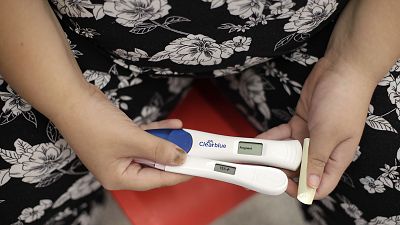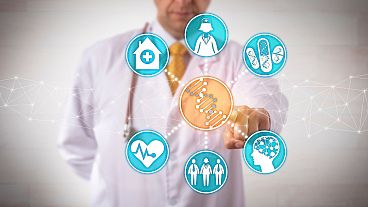Speaking at Davos, EU health boss Stella Kyriakides warned of the need to draw up safeguards on AI-driven tools used in the health sector including keeping human oversight over processes.
From machine learning easing diagnoses to the discovery of innovative drugs, artificial intelligence (AI) promises to disrupt the healthcare sector in the near future.
The EU has started to look into the use of such cutting-edge solutions in the health sector, weighing both positive and more controversial developments of AI.
“I believe that we can have all the potential that AI offers us and have the guardrails in place,” EU Commissioner for Health Stella Kyriakides told a panel at the World Economic Forum 2024’s Davos summit (17 January).
The bloc’s attempt to regulate this emerging technology through its pioneering Artificial Intelligence Act should be seen in the context of establishing some safeguards, according to the Commissioner.
Another key regulatory framework designed to channel the AI revolution is the European Health Data Space (EHDS), presented by the EU Executive in 2022 and currently being discussed by lawmakers.
“So much health data is out there, we saw it with Covid. We need to be able to pull this data so it can be used for innovation and research,” she said.
Data and trust
This new legislation will enable patients to share health data including medical history, test results, and prescriptions with hospitals and practitioners across all member states.
Once the EU health data infrastructure is up and running, researchers, institutions, and industry should be able to deploy AI to combine these vast real-time data pools.
Despite its evident potential, Kyriakides warned that the EHDS project might foster mistrust since “health data is very, very sensitive” for citizens.
“If people do not trust the system, the EHDS is not going to be able to bring the results we would like it to bring,” she said in Davos.
To avoid this scenario, the Commission has put forward safeguards enabling patients to “fully control their own health data and be able to exercise their rights.”
“Patients will have the choice to control which data they want to share, with whom they want to share it, and also have the choice if they don't want to share some of their data for any reason,” she said.
Likewise, the anonymity of health data will be guaranteed when it is collected in the context of research, she added.
Human touch
Kyriakides told Euronews on the sidelines of the panel that she views maintaining “human control in the process” as a key safeguard.
“The outcome of an AI-enabled process for diagnosis or to make a treatment more precise must be explainable and understandable both to the doctor and the patient,” she continued.
Use of radiology in cancer detection offers a good example of such diagnoses, she said, citing a Cancer Imaging Initiative – a common digital infrastructure to link different databases of cancer images across the EU – launched by the European Commission at the beginning of 2023.
However, even if AI systems offer the potential to save a huge amount of time spent in analysing pictures, medical expertise is still ultimately required for assessments and decisions.
“[Through this initiative], it will be possible to train new technologies that use artificial intelligence on large datasets to make more precise and faster clinical decisions, which can improve diagnosis and personalised care,” Kyriakides said.



